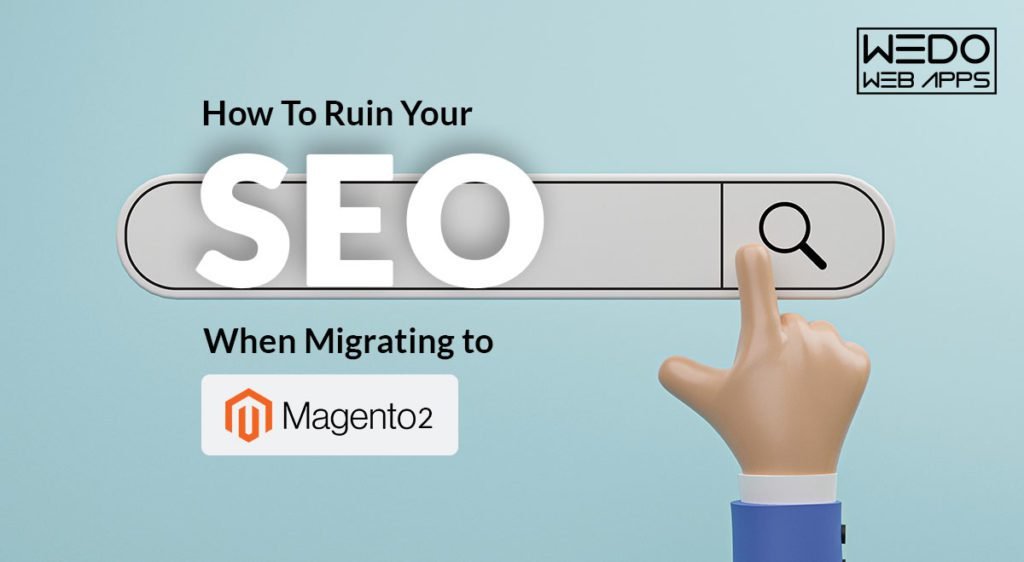21 Feb, 2023 | Magento development
How To Ruin Your SEO When Migrating to Magento 2

What Happens To SEO In The Migration Process?
Over time, your website has gained organic visibility and equity, which has helped you rank for keywords and searches that potential customers and clients use to find your website. What search engines know about your website and the metrics they use to give you rankings change when you change your URLs, content, and website. Therefore, any website migration aims to minimize traffic losses to the greatest extent possible; implementing a comprehensive SEO migration prevents losses.Common Mistakes That Leads To Ruining of SEO + Ways To Fix Them
1. Content Deletion Because No One Reads It Anymore
Do you want to read a fun stat about your traffic? Microsoft's study reveals that the average human attention span has shrunk from 12 seconds in 2000 to 8 seconds in 2018. Therefore, more engaging content is required to encourage visitors to remain on your website for longer. Videos or high-quality visuals that can be zoomed in to see the product in detail are great ways to engage customers and show off the effects. Reducing the amount of text on the website is usually logical because of changes in customer behavior. However, search engines still place a high value on original content when determining the search engine results pages rankings (SERPs). Therefore, keep the fundamentals in mind when planning to migrate your website to Magento 2.Ways To Fix This Problem
The most secure strategy for avoiding search engine rankings drops is to: either completely migrate the content or spend some time analyzing what, from an SEO standpoint, is worse to migrate and what can be left out because it will only help a little. SEO professionals frequently place the text directly above the footer to ensure the store is manageable with descriptions. Search engines still read it, but it does not prevent website visitors from purchasing the product.2. Don't Have A Clear Go-live Procedure
301 mapping is something you should care about. 404 errors are your biggest enemy! If it is not done correctly, it will affect all traffic channels, including email, paid, organic, social, and referral. If you changed your old website's URL to https://www.example.com/my-amazing-product from https://www.example.com/my-product, People who click on the old URL in search results, bookmarks, emails, Facebook posts, blog posts, etc., will open a page with the error 404 (Not Found), which can be dangerous!Ways To Fix This Problem
You should move the URLs of pages that do well so that you don't need 301 redirects in the first place. Map the critical URLs, such as CMS, categories, and products, if URLs are changing. From an SEO point of view, with valuable backlinks and quality traffic, you can keep the score intact.3. Launch The Website Without 301 Mapping.
Unfortunately, there is no hard and fast rule to direct the same SEO techniques for all. Although most SEO practices apply to almost every eCommerce store, specific settings may cause more harm than good in some instances. For instance, if you use Google to search for the robots.txt file for Magento 2 and blindly copy any robots.txt file that comes up, you risk hurting your SEO by blocking URLs that shouldn't be stopped. That may save some money on the crawl, but it will lower rankings overall.Ways To Fix This Problem
Based on the particulars of your store, developer requirements should be crystal clear. Make your configurable products, like smartphones with different memory, indexable with additional on-page optimization if they have variants that can rank independently and attract visitors with high shopping intent. Keep such pages out of the index to avoid spending crawl budgets on low-quality URLs if there are no searches for your product variants, such as people not looking for specific shoe sizes. Before going live, any setup should be tested for quality and, ideally, cross-checked after. Ensure a seamless Magento 2 migration with the guidance of a trusted digital marketing company USA, protecting your SEO throughout the process.4. Don't Go Live Without Proper Data Tracking
Do you know that roughly 90% of the setups for Google Analytics are somehow broken? The decisions made during the planning phase can be validated, and, if necessary, improvements can be planned by properly tracking eCommerce data and traffic.Ways To Fix This Problem
Similar to SEO, Analytics should have its own set of requirements.- Use QnA for Test and live environments
- Check with Google Search Console (or, in some cases, Bing or/and Yandex webmaster)
- Keeping SEO Until The Last Minute

5. Not Involving SEO professionals before migrating to Magento 2:
- Most technical SEO best practices in Magento 2 can be implemented with extensions. However, if requested too late, optimization of page speed—for instance—may impact the project's timeline. Additionally, no one enjoys missing deadlines.
- Due to SEO, you might have to redo some functionality on some custom projects. For instance, if you want the URL structure to match the more complex structure of your existing site, remodeling everything before go-live may require additional resources.
- Suppose SEO is not included in the project's scope, but your Magento store relies on organic traffic. In that case, you may experience a significant drop in traffic after the store is launched.
Ways to Fix This Problem
- Goals!
- Convene on a Q&A procedure for implementing changes that developers, your in-house SEO team, or a third-party SEO company will carry out.
- Before going live, conduct SEO technical audits to ensure all significant bugs have been found and fixed.
- Prepare a concise task list for developers to follow during go-live.
- Organic traffic KPIs should be closely monitored for at least a few weeks after go-live.
How to Migrate to Magento 2 Without Harming Your SEO Performance and Results?
When migrating to Magento 2, you need to follow the following steps with respect to SEO:- Crawl the current site.
- Keep track of your targets.
- Create a URL map.
- Check that titles, meta descriptions, and HTML markup are preserved.
- Test the new version on a test server
- Select an appropriate migration date.
- Prepare to update the DNS settings of your website.
- Launch
- Explore the new website.
- Find and fix content that is missing or duplicated.
- Look for chains of redirects.
- Make sure that Google Search Console and Analytics are used.
- In Analytics, mark the date.
- Send sitemaps in.
- Keep an eye on your work.
- Audit the site.
- Refresh your platforms.
- Request backlink updates from publishers.
1. Crawl The Current Site
Before migration, crawl the current location. The URLs and markup on your website are retrieved by search engine crawlers, who "see" this information in the same way that Google would. When you crawl, you get a list to look at in case something gets lost in translation and a starting point for your URL mapping (more on that later). Then, you can crawl your website by using a tool from a third party like Screaming Frog.2. Keep Track Of Your Targets
During a site migration, analytics data may be lost in some instances. However, because historical benchmarks can be valuable, it is best to keep them. Also, look over your analytics and ensure you know how visitors currently move around the site and which pages are most valuable to you. Your decisions regarding the website redesign and site architecture can benefit from this context.3. Create A URL Map
You will need to implement redirects to direct Google and your website visitors from your previous URLs to your new ones if you are making significant changes to the URLs on your website. From a usability standpoint, you shouldn't give users a 404 status code error if a page no longer exists. Instead, they should be directed to the page that has replaced the previous page. Your SEO could improve significantly if you use correct redirects. They inform visitors of your website and search engines that a page has changed, whether it has been removed or no longer exists. Additionally, they tell search engines which new pages have replaced older ones. If there aren't "perfect" replacements for every piece of content, don't worry. Instead, please make every effort to direct your users in their intended direction. Look for patterns in your URLs that can be redirected in groups or sections to save time if you have a lot of pages. Manual mapping is probably only an option if you have a few pages. It is necessary to migrate any redirects that already exist. Make sure your URLs are mapped before testing redirects to ensure that you have backups in case you lose them, and try to keep as many existing redirects as possible to reduce workload.4. Check To See That Titles, Meta Descriptions, And HTML Markup Are Preserved
Keep in mind that website migrations aid in the organization of websites. As a result, pages should be consistent and include the same catalog data as before. Titles, meta descriptions, and HTML markup can be permanently changed, but you should still ensure that each page has the correct information.5. Test The New Version On A Test Server
You will not completely understand the functionality and implementation of the new website if you only look at mockups or test them locally. Therefore, test drive it online before the official migration to ensure a smooth transition.6. Select An Appropriate Migration Date
No matter what, glitches will occur, but you can minimize them by avoiding peak times. Like if your traffic is high during the day, plan the migration in the night.7. Migration Day Prepare To Update The DNS Settings Of Your Website
"Pointing" to the new location of your website will be a part of the process if you move it to a different server. Work with your web/IT team or both new and old hosting providers.8. Launch
Establish your forwarding redirects, depublish them, and put them into action. The website might be temporarily unavailable if DNS changes were involved. The migration should be nearly instantaneous if you are not switching platforms or servers.9. Explore The New Website
You can conduct a crawl to determine whether the new site has been migrated in the manner you anticipated. A few things to look for include proper crawl ability and indexability.10. Find And Fix Content That Is Missing Or Duplicated
Check the search engine crawlers report to see if there are any unusual findings, such as duplicate content, 404 errors, or broken links. You should also look around the new website for problems.
11. Look For Chains Of Redirects
You now have a lot of new redirects as a result of the migration of your website. Chains could be formed if redirects were already in place. Fix Them. Fixing should be operational on the same day to prevent reporting or data gaps.12. In Analytics, Mark The Date
You can make "Annotations" of significant dates or events with Google Analytics. Unless you choose a new Analytics setup, this can help you contextualize the data and measure performance before and after the migration.13. Send Sitemaps In
Ensure your XML sitemap does not contain any errors once everything is up and running. After that, you can invite Google to crawl the new implementation by submitting the sitemap through Google Search Console.14. After The Migration, Keep An Eye On Your Work
Even though there may be brief drops in traffic following a migration, you should still monitor your analytics to ensure that nothing significant was missed that could affect performance.15. Audit The Site
Third-party tools may occasionally uncover issues that you were unaware of.16. Refresh Your Platforms
Make sure to add new inbound links whenever you have ads running on other platforms that may be using outdated URLs.17. Request Backlink Updates From Publishers
You will still receive traffic and authority from your backlinks if your redirects are implemented correctly. However, using the most recent URLs is still recommended. With this in mind, let the publishers of your most valuable links know about the switch.Conclusion
SEO for Magento 2 necessitates SEO expertise and a large number of settings. In addition, it takes time to improve the ranking significantly, but the corresponding increase in sales makes an effort well worth it. As a result, to fully optimize your website for search engine optimization (SEO), you should look for a third-party tool like the Magento 2 SEO extension. Also, these above-mentioned tips can make your website more SEO-friendly than ever!Frequently Asked Questions
You can improve SEO optimization by creating original and relevant content, regularly updating your content, including Metadata, having websites that can get links, etc.
Update Magento frequently, and speed up the Magento server; Varnish Cache can be enabled for Magento caching by allowing it to manage its cache, set up a network for content delivery, etc.
SEO Standard automatically adds schema structured data markup to the Magento 2 site, extending the default function. It aids in comprehending your content by Google and other search engines and displays useful information in organic searches.

